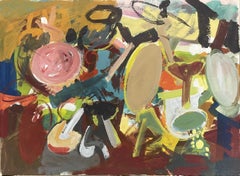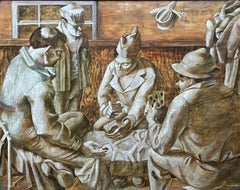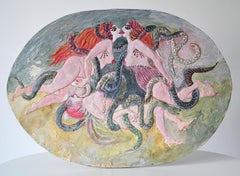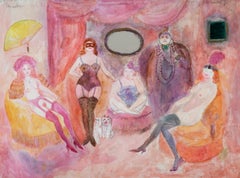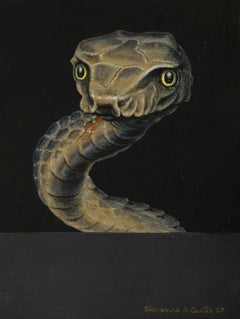Tempera Figurative Paintings
1950s Abstract Expressionist Tempera Figurative Paintings
Casein
1940s American Realist Tempera Figurative Paintings
Oil, Board, Tempera
1950s Abstract Expressionist Tempera Figurative Paintings
Casein
1980s Outsider Art Tempera Figurative Paintings
Plaster, Casein, Wood Panel
1990s Outsider Art Tempera Figurative Paintings
Mirror, Plaster, Casein, Wood Panel
1960s American Modern Tempera Figurative Paintings
Casein
2010s American Impressionist Tempera Figurative Paintings
Egg Tempera, Panel
Mid-20th Century American Modern Tempera Figurative Paintings
Panel, Tempera
1960s Surrealist Tempera Figurative Paintings
Illustration Board, Tempera
1960s Contemporary Tempera Figurative Paintings
Tempera
Mid-20th Century Tempera Figurative Paintings
Tempera
1960s Abstract Expressionist Tempera Figurative Paintings
Tempera, Pencil
1930s Abstract Expressionist Tempera Figurative Paintings
Tempera, Casein, Canvas
1940s American Realist Tempera Figurative Paintings
Egg Tempera, Masonite
Late 20th Century Tempera Figurative Paintings
Casein
2010s American Impressionist Tempera Figurative Paintings
Panel, Egg Tempera
1950s Hard-Edge Tempera Figurative Paintings
Casein
1940s American Modern Tempera Figurative Paintings
Board, Egg Tempera
2010s American Impressionist Tempera Figurative Paintings
Egg Tempera
1960s Outsider Art Tempera Figurative Paintings
Plaster, Wood, Casein
1930s American Realist Tempera Figurative Paintings
Tempera
1930s American Modern Tempera Figurative Paintings
Tempera
Early 2000s Contemporary Tempera Figurative Paintings
Egg Tempera, Panel, Gesso
21st Century and Contemporary Tempera Figurative Paintings
Crayon, Acrylic, Tempera, Canvas
21st Century and Contemporary Tempera Figurative Paintings
Crayon, Tempera, Canvas, Acrylic
1940s Modern Tempera Figurative Paintings
Masonite, Oil, Tempera
Early 2000s Contemporary Tempera Figurative Paintings
Panel, Tempera
15th Century and Earlier Old Masters Tempera Figurative Paintings
Tempera, Panel
Late 18th Century Baroque Tempera Figurative Paintings
Egg Tempera
1960s Surrealist Tempera Figurative Paintings
Watercolor, Tempera, Paper
1940s Tempera Figurative Paintings
Oil, Tempera
1950s Modern Tempera Figurative Paintings
Casein, Board
1940s American Modern Tempera Figurative Paintings
Masonite, Oil, Tempera
1940s American Modern Tempera Figurative Paintings
Masonite, Oil, Tempera
1940s American Modern Tempera Figurative Paintings
Masonite, Oil, Tempera
1940s Pre-Raphaelite Tempera Figurative Paintings
Canvas, Tempera, Mixed Media, Oil
1940s American Modern Tempera Figurative Paintings
Tempera, Board
1950s Abstract Tempera Figurative Paintings
Paper, India Ink, Casein
21st Century and Contemporary Renaissance Tempera Figurative Paintings
Gold Leaf
1940s Surrealist Tempera Figurative Paintings
Tempera
16th Century Renaissance Tempera Figurative Paintings
Parchment Paper, Egg Tempera
1970s Abstract Expressionist Tempera Figurative Paintings
Paper, Tempera
Late 20th Century American Realist Tempera Figurative Paintings
Paper, Casein
2010s Surrealist Tempera Figurative Paintings
Oil, Egg Tempera
Mid-20th Century Tempera Figurative Paintings
Tempera
2010s Surrealist Tempera Figurative Paintings
Oil, Egg Tempera
2010s Contemporary Tempera Figurative Paintings
Wood Panel, Egg Tempera
15th Century and Earlier Old Masters Tempera Figurative Paintings
Wood Panel, Tempera
1960s Post-Impressionist Tempera Figurative Paintings
Casein
1990s Abstract Expressionist Tempera Figurative Paintings
Pastel, Tempera, Cardboard
19th Century Other Art Style Tempera Figurative Paintings
Gold Leaf
20th Century American Modern Tempera Figurative Paintings
Tempera, Masonite
1970s Realist Tempera Figurative Paintings
Egg Tempera, Board
2010s Tempera Figurative Paintings
Egg Tempera
2010s American Impressionist Tempera Figurative Paintings
Cotton Canvas, Egg Tempera
1990s Abstract Expressionist Tempera Figurative Paintings
Tempera, Plastic
1990s Surrealist Tempera Figurative Paintings
Tempera
2010s American Impressionist Tempera Figurative Paintings
Egg Tempera
